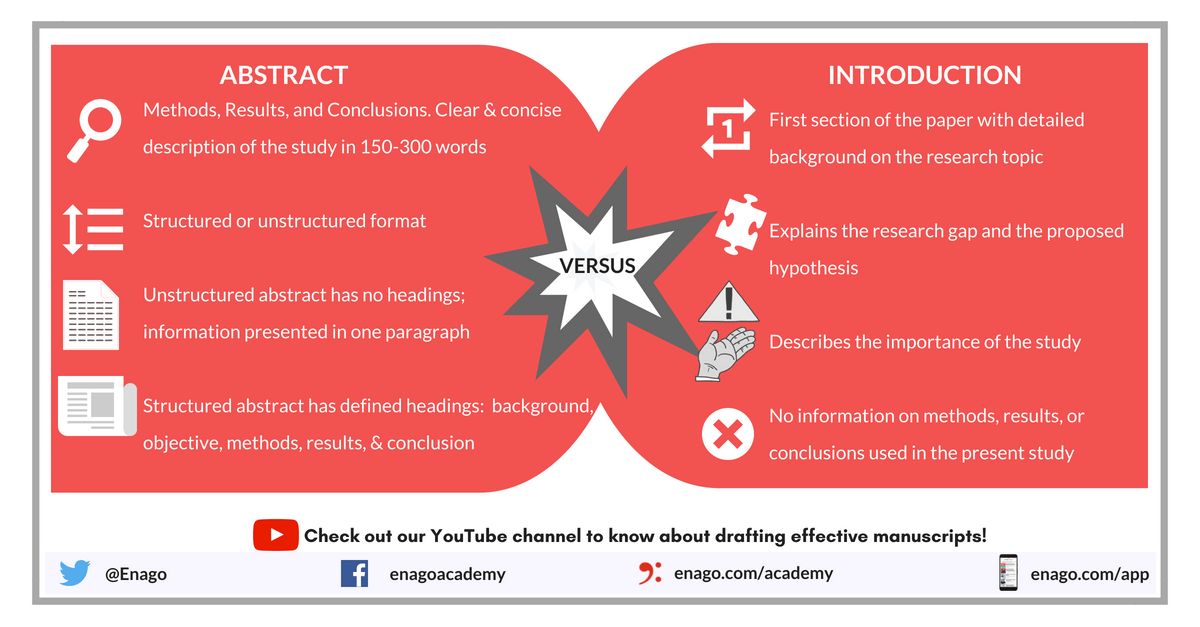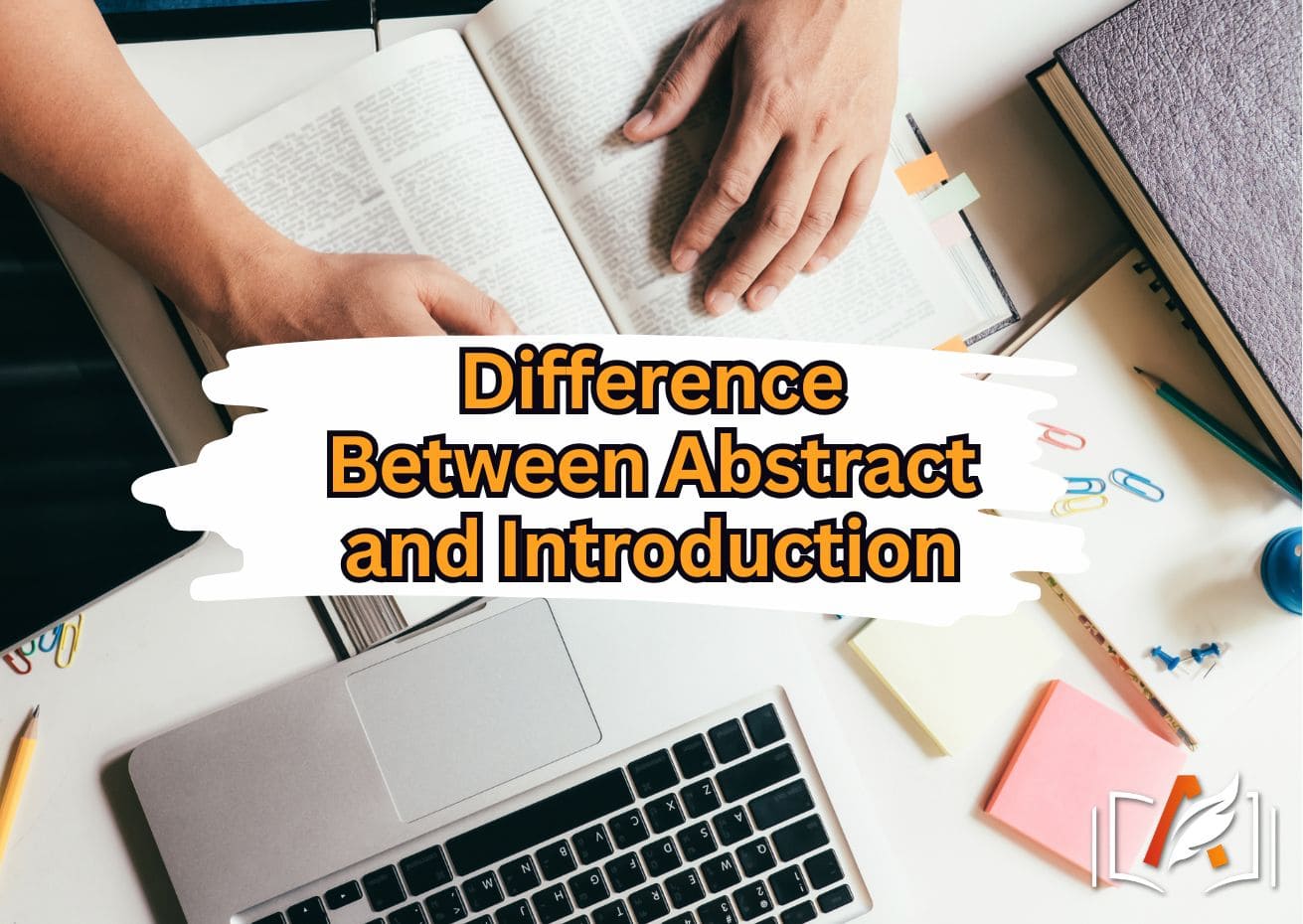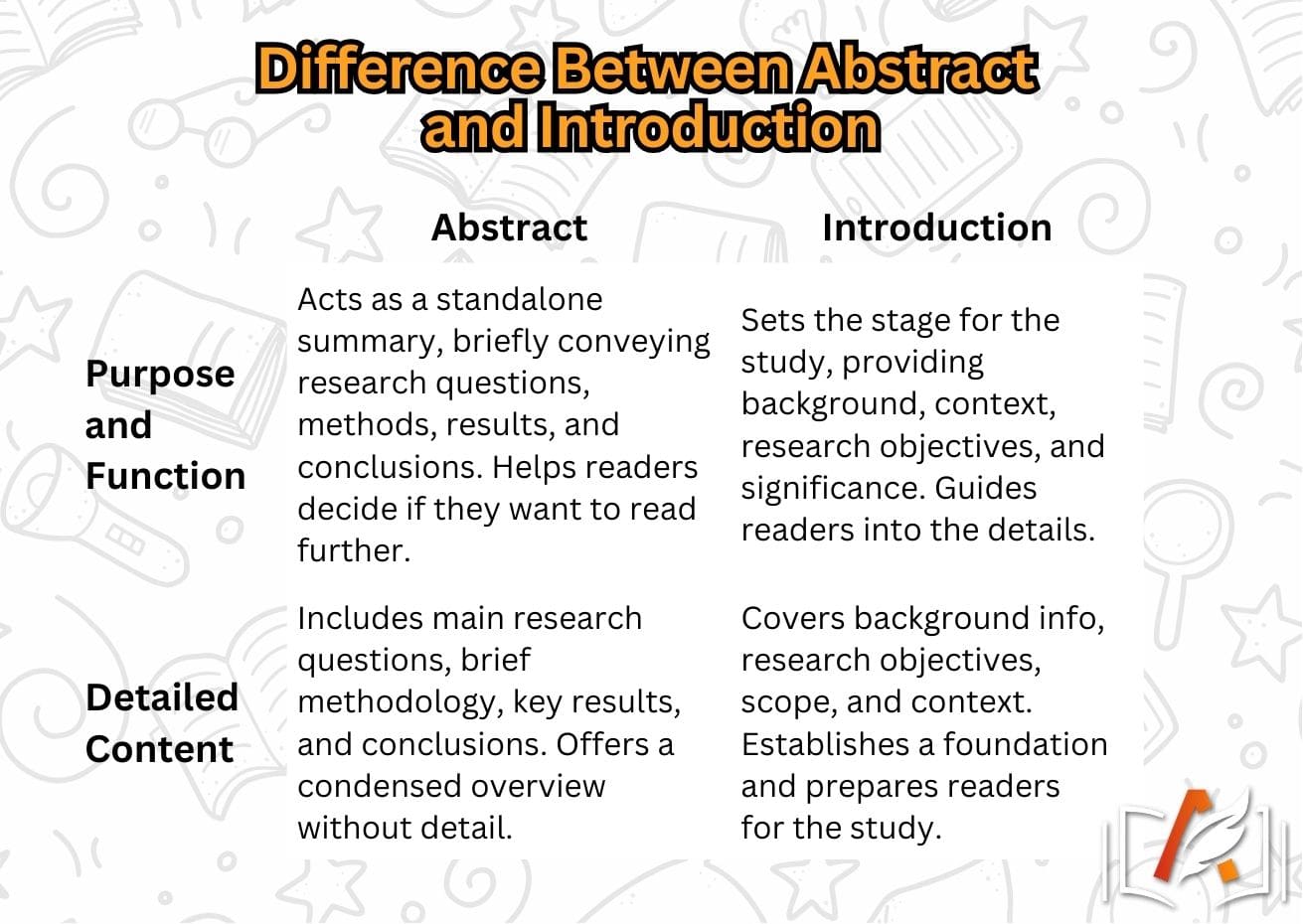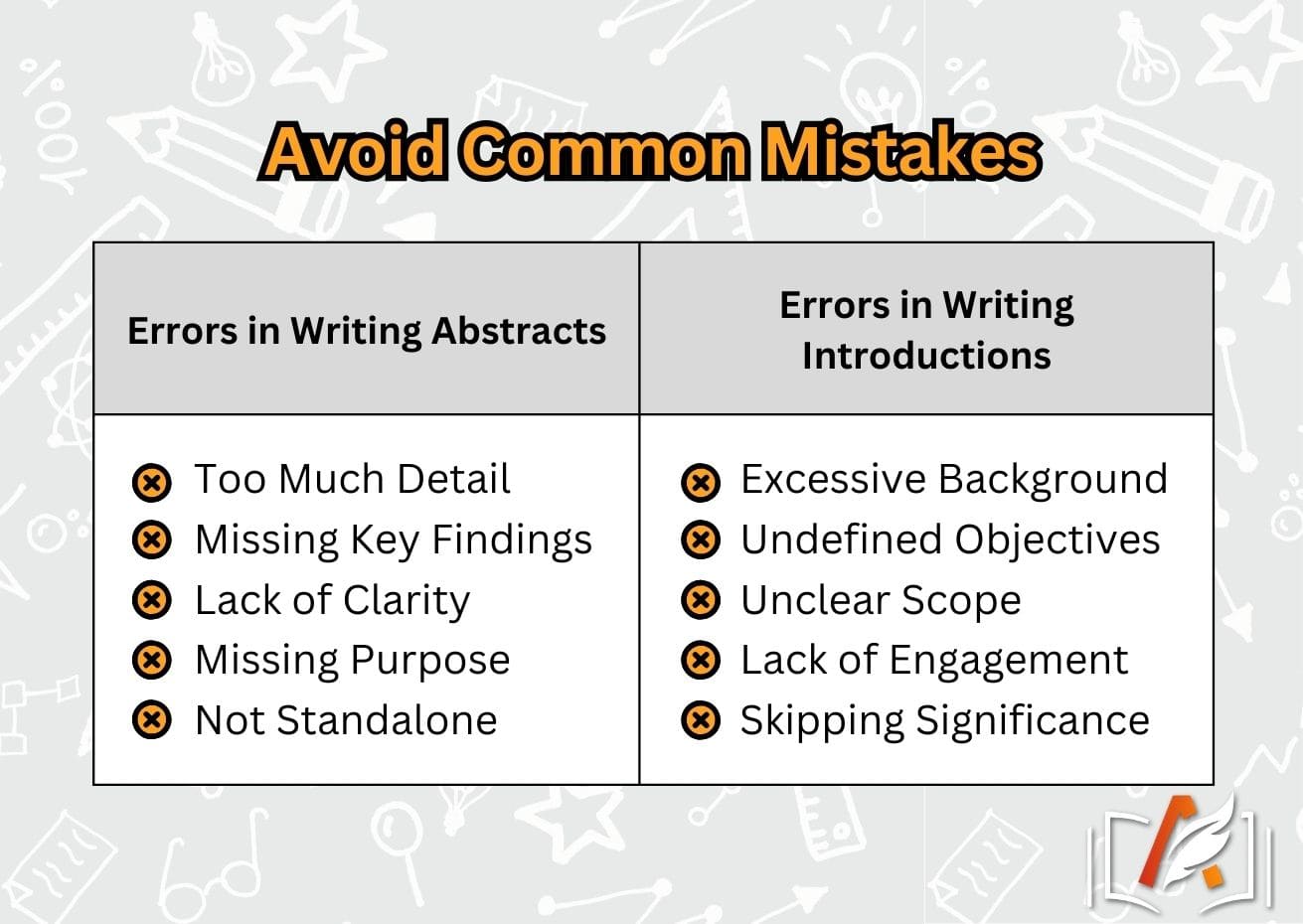- Research Process
- Manuscript Preparation
- Manuscript Review
- Publication Process
- Publication Recognition
- Language Editing Services
- Translation Services


What is the difference between an abstract and an introduction in academic writing?
- 5 minute read
- 70.8K views
Table of Contents
The abstract and the introduction are both crucial components of a paper, often positioned next to each other. While they may cover similar content, their writing approaches differ significantly. The abstract serves as a summary of the entire text, and on the other hand, the introduction sets the stage by highlighting the significance of the research and providing relevant background information.
In this discussion, we will delve deeply into the distinctions between the abstract and the introduction. We’ll begin by defining what they are, followed by a careful comparison of their characteristics, and conclude with detailed explanations of effective writing techniques, illustrated with examples. Let’s explore!
What is an ‘Abstract’ ?
An abstract is a concise summary of the different sections of your research paper, encompassing the research objectives, methods, conclusions, and other key elements. It typically also includes a statement on the novelty or relevance of your research and suggests directions for future work.
Meant to be a stand-alone summary, the abstract should cover all the essential elements of your study, allowing readers to quickly decide whether the paper aligns with their area of interest. Most journals have a strict word limit for abstracts; usually 10% of the total word count of the research paper.
Typically, the abstract should emphasize the key findings of your study and incorporate important keywords that reflect current trends in research. This not only aids in enhancing the visibility of your paper but also draws the attention of readers to your work.
The writing format of an abstract can generally be classified into two categories: structured and single paragraph/unstructured. The structured format delineates sections based on the paper’s structure, summarizing the background, methods, conclusions, and other elements separately, with subheadings for clarity. In contrast, the single-paragraph format combines all information into one cohesive paragraph 1 . A structured format with clearly delineated sections can help readers find specific information quickly and may be the preferred format for writing abstracts for some journals.
Here is an example of a structured abstract from a recent European Journal of Cancer publication 2 :

An unstructured abstract, on the other hand, combines these elements into a single paragraph, and is a great test of your ability to summarize . Below is an example of an unstructured abstract from the journal Environmental Research 3 :

What is an ‘ Introduction ’?
The introduction is the first section of a research paper that follows the abstract. It provides the background information necessary for the reader to understand the topic and objective of the study. Importantly, the introduction highlights the gaps in what is currently known about the topic and how your research aims to address those gaps. While discussing and building upon previous findings to narrow down on the specific research objective, it is advisable to list previous studies in chronological order, complete with citations, explaining why the current study was warranted.
A well-written introduction sets the stage for the entire paper, distinguishing the known from the unknown in your research area. It demonstrates the importance of your hypothesis and clarifies how your findings contribute to the broader field. When writing an introduction, researchers should be concise and focus on relevant content, avoiding any unnecessary or redundant information.
To enhance clarity and readability in the introduction, researchers can utilize a segmented presentation format. Here is the an example of introduction section :

(This introduction and the segmented abstract in the previous article are selected from the same article 2 )
After understanding the differences between the abstract and the introduction, you may want to consider the following writing suggestions:
- Writing Logic: Start with the research topic, explain the rationale for choosing it, present research hypotheses, and summarize research results.
- Provide readers with a comprehensive overview of the research without delving into excessive details.
- Conclude with a compelling statement to spark readers’ interest in the full paper.
- Ensure the accuracy of data. Any discrepancies between the abstract and the main text can undermine the credibility of the research.
- Adhere to the format requirements of the target journal, as different journals have varying regulations. For example, some may require segmented abstracts for specific categories of papers.
Introduction
- Summarize the research topic briefly while identifying the gaps the article aims to address. Citing relevant data or current trends can strengthen your argument.
- Clarify why this research direction was chosen and explicitly state the goals.
- Provide necessary background information and introduce research hypotheses by reviewing related studies.
- Outline key concepts and research methods that will be elaborated on later in the article, ensuring that readers grasp the context before engaging with the details 4 .
- Keep the text concise and avoid overwhelming readers with excessive information that may distract from the main points.
Often, writing the first few sections of your paper can feel like a daunting task. Understanding the differences between an abstract and an introduction is thus, crucial for crafting a well-structured and engaging research paper.
In addition to the writing suggestions above, consider partnering with a professional language service agency for efficient support. The editorial team at Elsevier Language Services comprises native English speakers with expertise across more than 100 subjects. We quickly identify the key issues in your manuscript based on top journal standards, offering customized guidance and suggestions that significantly enhance the quality of your work. This not only saves you time and effort but also alleviates concerns throughout the publication process. For more details, please click here to visit our official website.
- Chartier M. Abstract vs. Introduction: What is the actual difference? Fourwaves. Published December 7, 2022. https://fourwaves.com/blog/abstract-vs-introduction/
- Luke, Jason J., et al. “Safety of Pembrolizumab as Adjuvant Therapy in a Pooled Analysis of Phase 3 Clinical Trials of Melanoma, Non–Small Cell Lung Cancer, and Renal Cell Carcinoma.” European Journal of Cancer , vol. 207, 2024, p. 114146, sciencedirect.com/science/article/pii/S0959804924008025
- Murphy, Malia SQ., et al. “Association Between Prenatal Air Pollutant Exposure and Autism Spectrum Disorders in Young Children: A Matched Case-Control Study in Canada.” Environmental Research , vol. 261, 2024, p. 119706, sciencedirect.com/science/article/pii/S0013935124016116
- llis M. Here’s How to Write an Introduction (with Examples and Tips). Here’s How to Write an Introduction (Examples and Tips) | Grammarly. Published May 8, 2018. https://www.grammarly.com/blog/how-to-write-an-introduction/

Scholarly Sources: What are They and Where can You Find Them?

What are Implications in Research?
You may also like.

Submission 101: What format should be used for academic papers?

Page-Turner Articles are More Than Just Good Arguments: Be Mindful of Tone and Structure!

A Must-see for Researchers! How to Ensure Inclusivity in Your Scientific Writing

Make Hook, Line, and Sinker: The Art of Crafting Engaging Introductions

Can Describing Study Limitations Improve the Quality of Your Paper?

A Guide to Crafting Shorter, Impactful Sentences in Academic Writing

6 Steps to Write an Excellent Discussion in Your Manuscript

How to Write Clear and Crisp Civil Engineering Papers? Here are 5 Key Tips to Consider
Input your search keywords and press Enter.
- Call for Articles
- Login

Abstract Vs. Introduction — Do you know the difference?
Ross wants to publish his research. Feeling positive about his research outcomes, he begins to draft his manuscript. After completing the abstract, he proceeds to write the introduction. That’s when he pauses in confusion. Do the abstract and introduction mean the same? How is the content for both the sections different?
This is a dilemma faced by several young researchers while drafting their first manuscript. An abstract is similar to a summary except that it is more concise and direct. Whereas, the introduction section of your paper is more detailed. It states why you conducted your study, what you wanted to accomplish, and what is your hypothesis.
This blog will allow us to learn more about the difference between the abstract and the introduction.
What Is an Abstract for a Research Paper?
An abstract provides the reader with a clear description of your research study and its results without the reader having to read the entire paper. The details of a study, such as precise methods and measurements, are not necessarily mentioned in the abstract. The abstract is an important tool for researchers who must sift through hundreds of papers from their field of study.
The abstract holds more significance in articles without open access. Reading the abstract would give an idea of the articles, which would otherwise require monetary payment for access. In most cases, reviewers will read the abstract to decide whether to continue to review the paper, which is important for you.
Your abstract should begin with a background or objective to clearly state why the research was done, its importance to the field of study, and any previous roadblocks encountered. It should include a very concise version of your methods, results, and conclusions but no references. It must be brief while still providing enough information so that the reader need not read the full article. Most journals ask that the abstract be no more than 200–250 words long.
Format of an Abstract
There are two general formats — structured and unstructured. A structured abstract helps the reader find pertinent information very quickly. It is divided into sections clearly defined by headings as follows:
- Background : Latest information on the topic; key phrases that pique interest (e.g., “…the role of this enzyme has never been clearly understood”).
- Objective : The research goals; what the study examined and why.
- Methods : Brief description of the study (e.g., retrospective study).
- Results : Findings and observations.
- Conclusions : Were these results expected? Whether more research is needed or not?
Authors get tempted to write too much in an abstract but it is helpful to remember that there is usually a maximum word count. The main point is to relay the important aspects of the study without sharing too many details so that the readers do not have to go through the entire manuscript text for finding more information.
The unstructured abstract is often used in fields of study that do not fall under the category of science. This type of abstracts does not have different sections. It summarizes the manuscript’s objectives, methods, etc., in one paragraph.
Related: Create an impressive manuscript with a compelling abstract. Check out these resources and improve your abstract writing process!
Lastly, you must check the author guidelines of the target journal. It will describe the format required and the maximum word count of your abstract.
What Is an Introduction?
Your introduction is the first section of your research paper . It is not a repetition of the abstract. It does not provide data about methods, results, or conclusions. However, it provides more in-depth information on the background of the subject matter. It also explains your hypothesis , what you attempted to discover, or issues that you wanted to resolve. The introduction will also explain if and why your study is new in the subject field and why it is important.
It is often a good idea to wait until the rest of the paper is completed before drafting your introduction. This will help you to stay focused on the manuscript’s important points. The introduction, unlike the abstract, should contain citations to references. The information will help guide your readers through the rest of your document. The key tips for writing an effective introduction :
- Beginning: The importance of the study.
- Tone/Tense: Formal, impersonal; present tense.
- Content: Brief description of manuscript but without results and conclusions.
- Length: Generally up to four paragraphs. May vary slightly with journal guidelines.

Once you are sure that possible doubts on the difference between the abstract and introduction are clear, review and submit your manuscript.
What struggles have you had in writing an abstract or introduction? Were you able to resolve them? Please share your thoughts with us in the comments section below.
Insightful and educating Indeed. Thank You
Quite a helpful and precise for scholars and students alike. Keep it up…
thanks! very helpful.
thanks. helped
Greeting from Enago Academy! Thank you for your positive comment. We are glad to know that you found our resources useful. Your feedback is very valuable to us. Happy reading!
Really helpful as I prepare to write the introduction to my dissertation. Thank you Enago Academy
This gave me more detail finding the pieces of a research article being used for a critique paper in nursing school! thank you!
The guidelines have really assisted me with my assignment on writing argument essay on social media. The difference between the abstract and introduction is quite clear now for me to start my essay…thank you so much…
Quite helpful! I’m writing a paper on eyewitness testimony for one of my undergraduate courses at the University of Northern Colorado, and found this to be extremely helpful in clarifications
This was hugely helpful. Keep up the great work!
This was quite helpful. Keep it up!
Very comprehensive and simple. thanks
As a student, this website has helped me greatly to understand how to formally report my research
Thanks a lot.I can now handle my doubts after reading through.
thanks alot! this website has given me huge clarification on writing a good Introduction and Abttract i really appreciate what you share!. hope to see more to come1 God bless you.
Thank you, this was very helpful for writing my research paper!
That was helpful. geed job.
Thank you very much. This article really helped with my assignment.
Woohoo! Amazing. I couldnt stop listening to the audio; so enlightening.
Thank you for such a clear breakdown!
I am grateful for the assistance rendered me. I was mystified over the difference between an abstract and introduction during thesis writing. Now I have understood the concept theoretically, I will put that in practice. So thanks a lots it is great help to me.
Rate this article Cancel Reply
Your email address will not be published.

Enago Academy's Most Popular Articles

- AI in Academia
- Infographic
- Manuscripts & Grants
- Reporting Research
- Trending Now
Can AI Tools Prepare a Research Manuscript From Scratch? — A comprehensive guide
As technology continues to advance, the question of whether artificial intelligence (AI) tools can prepare…

- Old Webinars
- Webinar Mobile App
Demystifying Research Methodology With Field Experts
Choosing research methodology Research design and methodology Evidence-based research approach How RAxter can assist researchers

- Manuscript Preparation
- Publishing Research
How to Choose Best Research Methodology for Your Study
Successful research conduction requires proper planning and execution. While there are multiple reasons and aspects…

Top 5 Key Differences Between Methods and Methodology
While burning the midnight oil during literature review, most researchers do not realize that the…

如何准备高质量的金融和科技领域学术论文
如何寻找原创研究课题 快速定位目标文献的有效搜索策略 如何根据期刊指南准备手稿的对应部分 论文手稿语言润色实用技巧分享
How to Draft the Acknowledgment Section of a Manuscript
Discussion Vs. Conclusion: Know the Difference Before Drafting Manuscripts
Annex Vs. Appendix: Do You Know the Difference?

Sign-up to read more
Subscribe for free to get unrestricted access to all our resources on research writing and academic publishing including:
- 2000+ blog articles
- 50+ Webinars
- 10+ Expert podcasts
- 50+ Infographics
- 10+ Checklists
- Research Guides
We hate spam too. We promise to protect your privacy and never spam you.
- Plagiarism Checker
- AI Content Detector
- Academic Editing
- Publication Support Services
- Thesis Editing
- Enago Reports
- Journal Finder
- Thought Leadership
- Promoting Research
- Diversity and Inclusion
- Industry News
- Al in Academia
- Career Corner
- Other Resources
- Infographics
- Enago Learn
- On-Demand Webinar
- Open Access Week
- Peer Review Week
- Publication Integrity Week
- Conference Videos
- Call for speakers
- Author Training
I am looking for Editing/ Proofreading services for my manuscript Tentative date of next journal submission:

What features do you prefer in a plagiarism detector? (Select all that apply)
- Key Differences
Know the Differences & Comparisons
Difference Between Abstract and Introduction

On the other hand, the abstract is like a short summary of an academic article or research paper, which discusses the purpose of the study and the outcome of the research. It usually summarizes the research topic, questions, participants, methods, outcome, data collected, analysis and conclusions. The article excerpt given hereunder discusses the difference between abstract and introduction.
Content: Abstract Vs Introduction
Comparison chart, definition of abstract.
An abstract can be described as a concise summary, often found in research work like thesis, dissertations, research articles, review, etc. which helps the reader to have an instant idea of the main purpose of the work. It is about a paragraph long of 150 to 250 words in general.
The information contained in the abstract should be sufficient enough to help the readers judge the nature and importance of the topic, the reasonableness of the strategy used in the investigation, nature of results and conclusions.
An abstract serves a number of purposes such as it allows the readers to get the gist of your paper, so as to decide whether to go through with the rest of the work. It is usually written after the writing of the paperwork is over and that too in the past tense.
An abstract rolls all the important information of the work into a single page, such as the context, general topic, central questions, problem under study, main idea, previous research findings, reasons, research methodology, findings, results, arguments, implications, conclusion and so on. To create an abstract one should pick the main statements from the above-mentioned sections, to draft an abstract.
Types of Abstract
- Descriptive Abstract : It briefly describes the abstract and the length is usually 100-200 words. It indicates the type of information contained in the paper, discusses the purpose of writing, objectives and methods used for research.
- Informative Abstract : As the name suggests, it is a detailed abstract which summarizes all the important points of the study. It includes results and conclusions, along with the purpose, objective, and methods used.
Definition of Introduction
Introduction means to present something to the readers, i.e. by giving a brief description or background information of the document. It is the first and foremost section which expresses the purpose, scope and goals, concerning the topic under study. As an introduction gives an overview of the topic, it develops an understanding of the main text.
An introduction is a gateway to the topic, as it is something which can create interest in the readers to read the document further. It is the crux of the document, which states what is to be discussed in the main body.
Elements of Introduction
An introduction has four basic elements namely: hook, background information, connect and thesis statement.
- Hook is the preliminary sentence of the introduction which is used to fasten the attention of the readers, and so it has to be interesting, attention-grabbing, and readable of course, so as to stimulate the readers to read the complete text.
- Background Information is the main part of the introduction, which presents the background of the research topic, including the problem under study, real-world situation, research questions, and a sneak peek of what the readers can expect from the main body.
- Connect , is a simple line which is used to link or say relate the background information with the research statement, by using words ideas or phrases, so as to ensure the flow and logic of writing the text.
- Thesis statement is the central point of the argument, which is usually a single sentence, whose points of evidence are to be talked about in the following text, i.e. the main body.
Key Differences Between Abstract and Introduction
The difference between abstract and introduction are discussed in the points:
- An abstract is a concise and accurate representation which gives an overview of the main points from the entire document. On the other hand, Introduction is the first section which makes the reader aware of the subject, by giving a brief description of the work, i.e. why the research is needed or important.
- While an abstract will give you an immediate overview of the paper, the introduction is the initial exposure to the subject under study.
- An abstract reports key points of the research, as well as it states why the work is important, what was the main purpose of research, what is the motivation behind choosing the subject, what you learned from the research, what you found out during the research and what you concluded, in a summarized way. As against, an introduction presents a direction to understand what exists in the upcoming portion of the document or book.
- As an abstract has its own introduction, main body and conclusion, it is a standalone document which summarizes the result of the findings and not just the list of topics discussed. As against, the introduction is not a standalone document or piece.
- The main purpose of an abstract is to provide a succinct summary of the research. Conversely, introduction aims at convincing the reader about the need for the research.
- An abstract contains the purpose, problem, methods used, result and conclusion. On the contrary, the introduction includes a hook, background information, connect and thesis statement.
- While abstract is found in a research paper, thesis and dissertations, the introduction is found in a wide range of texts.
An abstract gives a preview of the work, outlines the main points and helps the audience in decision making, i.e. whether they want to read the complete text or not. On the other hand, an introduction is the very first section of the work, which clarifies the purpose of writing.
Without an abstract and introduction, the readers might not be able to know what the work contains and what is the reason or motivation behind the research. So, these two are like thread which goes through the writing and creates an understanding in the reader about the topic under study. While writing these two, one should ensure that they accurately reflect what you cover in the document or book.
You Might Also Like:

Edward says
September 20, 2023 at 1:15 am
fantastic explanations
Leave a Reply Cancel reply
Your email address will not be published. Required fields are marked *
Save my name, email, and website in this browser for the next time I comment.
Abstract vs. Introduction—What's the Difference?
#scribendiinc
Written by Scribendi
Have you been writing your paper only to get stuck when you get to your abstract and introduction?
Despite being at the beginning of our papers, abstracts and introductions are often the last things we write and can sometimes be the toughest. Before you begin writing your abstract and introduction, you should understand their purpose and how they differ from each other.
By doing so, you can improve your writing and ensure both sections serve their roles, supporting the rest of your paper and making a positive first impression on your readers.
So, here's everything you need to know about abstracts and introductions, including their fundamental differences.
What Is an Abstract?
An abstract is a summary of your paper, providing the following key information:
- The context of your research
- The problem(s) your research addresses
- The goals of your research
- Your research methods
- Your sample size
- Your primary findings
- The significance of your findings
- The main conclusions of your research
What Is the Purpose of an Abstract?
An abstract aims to generate interest in your paper and quickly give readers a sense of its content. Readers may also refer back to an abstract after finishing your paper, as it can remind them of your key points and findings.
The content of abstracts can vary depending on the type of work. When learning how to write an abstract , you'll see that some abstracts serve primarily as descriptions and may not present specific research outcomes.
In contrast, informative abstracts may provide more detailed insights into the findings and implications of your research.
The Impact on Visibility
Abstracts are often the first and sometimes the only part of a paper that is read. If you want to gain as much visibility for your research as possible, you'll need to pay particular attention to this section.
A high-quality abstract can increase citation rates and reader engagement, exposing your paper to a wider audience.
In this study , the researchers referred to other papers to highlight the importance and impact of considering search engine optimization and including relevant keywords in abstracts.
A similar paper emphasized how the purpose of an abstract is to reinforce the primary keywords from the title. While this paper recommends being cautious not to overoptimize your abstract, including keywords and phrases up to four times can improve your rankings on search engine results pages.
Example of an Abstract
We can look at excerpts from an abstract written for a paper studying the relationship between Instagram use frequency, exposure to idealized images, and psychological well-being in women .
"This study aimed to address the link between Instagram use and a range of psychological variables in two parts."
"Participants were 129 women aged between 18 and 35 years."
"Beauty and fitness images significantly decreased self-rated attractiveness, and the magnitude of this decrease correlated with anxiety, depressive symptoms, self-esteem, and body dissatisfaction. Therefore, excessive Instagram use may contribute to negative psychological outcomes and poor appearance-related self-perception, in line with prior research."
"The research has implications for interventions and education about chronic Instagram use."
While the full abstract provides more details, these excerpts highlight important information the writer has included, such as the study's purpose, methodology, participant demographics, key findings, and implications.
This information gives readers a quick look at the research and its significance, as the abstract summarizes the main details of the entire paper.
Strategic Tips for Writing Abstracts
As abstracts are critical to your paper's visibility and engagement, it's important to take your time when writing one, carefully considering what to include and how to structure it.
Use active verbs rather than passive verbs whenever possible. Active verbs such as "identifies," "explores," "highlights," "proposes," "utilizes," and "challenges" are high impact and add energy to your abstract, helping you engage your readers from the get-go.
Abstracts are also more impactful when written in the third person, which establishes an objective and professional tone. For example, the abstract of this study ends with "This paper will further elaborate on the relative merits of each tumor type as a model for human cancer therapy and biology" rather than with "My paper will …."
In most scientific and academic contexts, findings from research are viewed as contributions to a broad body of knowledge rather than personal discoveries, so writing in the third person rather than the first helps the writer frame their results as part of ongoing academic research.
Tailoring to Audiences
When writing your abstract, consider your field and your reader's expertise, and tailor it to your audience by adjusting your language, tone, and focus.
For a clinical research paper, you may bring focus to your methodology, results, and implications. Other researchers or professionals in the field will require a concise and informative abstract to immediately determine the paper's relevance and the research's applicability for their work.
In contrast, in sociological research, abstracts can focus more on context, theory, and conceptual analysis rather than on practical outcomes. Researchers in this field may find more value in new perspectives and frameworks outlined in the abstract than in immediate outcomes or findings.
Consider who will most likely encounter your paper's abstract and what they're looking for so you can include appropriate and helpful information.
What Is an Introduction?
An introduction is your paper's opening section, which includes the following:
- The broader context of your research
- The objectives and aims of your research
- Your main argument
- The rationale for your research methods
- An overview of the structure of the paper
What Is the Purpose of an Introduction?
Introductions convince readers of your paper's importance and relevance. Through your introduction, you can also showcase the quality of your work, your analytical skills, and your writing style.
In our essay introduction examples , we show how an attention-grabbing and professional introduction can engage readers, prompt them to take an interest in your research, and read the rest of your paper.
That's why, like many writers do to hook readers, you can begin your introduction with an interesting and relevant fact, question, or quote.
Your introduction can also include relevant keywords to improve your visibility in search engines. Remember to incorporate them naturally and ensure they don't disrupt the flow of your writing.
Example of an Introduction
Here are important excerpts from an introduction to a paper on anticipatory behavior in animals :
"Animals can use the knowledge they acquire about temporal and spatial patterns to predict when and where resources may be found and thus better exploit opportunities. In this way, animals use environmental cues to anticipate a reward and exploit this knowledge to better direct their behavior."
"However, in the anticipatory behavior literature, it is often unclear what if any function the behaviors reported actually achieve in helping the animal acquire a reward."
"This absence of theory may explain: i) why some studies rely on meta-behaviors, such as the frequency of behavioral elements or transitions (henceforth called behavioral transitions) as the outcome measure (e.g. van den Bos et al. 2003); ii) the bewildering variation in anticipatory behaviors described in different situations and for different species; and iii) why authors sometimes draw similar inferences based upon divergent (and even contradictory) evidence."
"The aim of the current paper is to examine the conceptual and empirical foundations of welfare-related inferences about anticipatory behavior."
"We begin with a discussion of classical conditioning and the interpretation of behaviors that occur during the interval between a cue and the presentation of the reward. We then discuss how superstitious learning may affect the behaviors expressed. We briefly describe the methodologies used and the differences in the inferences made from these studies. Finally, we discuss methodological confounds and provide suggestions for future study."
The introduction begins with an interesting fact, highlights the paper's context, refers to existing research, and indicates current gaps in understanding. The writer then discusses the paper's aim, main argument, and general structure, giving readers enough background information to interest them and guide them to the body content.
Strategic Tips for Writing Introductions
As with abstracts, your introduction can influence how your paper is perceived and engaged with. An introduction sets the stage for your paper, and from the first sentence, you should focus on drawing in and interesting your readers.
Avoid overused and generic opening sentences, such as "The dictionary defines ___ as …," "In today's society …" and "Throughout history …." Similarly, a basic sentence such as "The purpose of this study is to …" is uninspired and won't make a strong impression. These types of opening sentences lack any depth or originality, disengaging your readers and reducing your credibility.
Instead, your opening sentences should be unique and thought-provoking to hook your readers and convince them to continue reading.
For example, this study on applications and issues of nanotechnology begins its introduction as follows: "Science and technology continue to move forward in making the fabrication of micro or nanodevices and systems possible for a variety of industrial, consumer, and biomedical applications."
This opening sentence immediately establishes the focus and context of the paper while highlighting the broader impacts of the subject on various sectors (industrial, consumer, and biomedical), attracting a vast range of readers from different fields.
The above example also demonstrates how an introduction, similar to an abstract, can be tailored to different audiences. To target a wide audience with less specialized knowledge, the writer of this paper provides a brief description of nanotechnology and its applications rather than a highly technical or in-depth analysis.
The writer also uses accessible language and avoids detailed references to scientific processes or methods, which may be present in a paper aimed at more specialized or knowledgeable readers. For instance, the introduction includes a definition: "According to the National Science Foundation and NNI, nanotechnology is the ability to understand, control and manipulate matter at the level of individual atoms and molecules." This helps readers grasp the fundamental concept of nanotechnology and prepares them to understand the rest of the paper.
In contrast, this study on the interdisciplinarity of nanotechnology uses more technical language in its introduction and focuses on specific researchers and studies without any basic explanations or simplifications. For example, this sentence in the introduction may confuse audiences with limited background knowledge: "Convergence of diverse nano fields has been conceptualized in various ways, reflecting even the divergent top-down and bottom-up approaches of nanotechnology itself."
However, researchers and professionals in this field will appreciate precise and technical language rather than reading any information they already know, such as topic definitions.
Consider these examples when writing your paper's introduction to make sure you adjust your tone, use of language, and level of detail to cater to and subsequently interest your audience.
What Are the Differences Between an Abstract and an Introduction?
Here's how abstracts and introductions differ:
The Abstract Comes Before the Introduction
Serving as an advertisement for your paper by providing general information, the abstract is always the first section readers encounter, which is why it comes before the introduction.
Your introduction comes next and will expand on the details mentioned in the abstract, leading to the main body of your paper.
Abstracts Have Fewer Words Than Introductions
Abstracts are typically limited to 100–300 words. You need to be concise when summarizing your paper.
Introductions can be much longer, consisting of 500 or more words, and often correspond to the paper's overall length and complexity. Although the ideal length of an introduction may vary, a general rule of thumb is that it should be around 10% of your paper's total length.
In both cases, you should avoid providing excessive detail and stay focused.
An Introduction Is Brief While an Abstract Is More Detailed
Although abstracts are shorter than introductions, they often include more specific details about key aspects of the study.
Introductions typically provide only a broad overview, focusing on background information and the research question rather than detailed findings.
Only Introductions Contain Reference Citations
Introductions can include reference citations to ground the study and show its relevance. By including references, you can demonstrate how your paper builds on existing research while updating readers on the topic or the current state of knowledge in your field.
For example, in a section of this introduction , two valuable and interesting references are included:
"In contrast with maize and wheat, rice is mainly produced for human consumption (>80%), and rarely utilized as an animal feed (Müller-Fischer, 2013). In 2012, global rice paddy production was 731.2 million tons and, once milled, amounted to 487.5 million tons (FAO, 2013)."
Abstracts never include reference citations. When you write an abstract, you'll only focus on the details of your own paper.
Only Abstracts Summarize the Paper
An abstract provides a summary of your entire paper, including some of your findings and conclusions.
Introductions rarely include this information, as they mainly set up a paper's purpose and topic.
Abstract vs. Introduction in a Scientific Paper
When you write a scientific paper , the abstract summarizes your experiment, including your research question, methods, and results.
The introduction provides context for the research by explaining the problem, introducing relevant literature, and outlining the hypotheses.
Try our scientific editing services to ensure all sections of your paper, including your abstract and introduction, are clear and informative.
Abstract vs. Introduction in a Research Paper
In a research paper, the abstract provides a summary of your topic, the central questions or statements your research addresses, and the goals or rationale of your research.
The introduction will provide more background information, including a brief overview of relevant theories or related research, to ease readers into the detailed content of your paper.
Abstract vs. Introduction in an Essay
When writing or editing essays or similar forms of academic writing , the abstract highlights your main arguments and conclusions, while the introduction covers the topic in detail, provides background information, and presents the thesis statement.
Abstract vs. Introduction in a Dissertation
When writing or editing dissertations , ensure that the abstract covers your research's purpose, methodology, and key findings.
The introduction further defines the scope of your research while providing cited literature and briefly explaining your dissertation's relevance and contribution to your topic.
Common Mistakes to Avoid When Writing Abstracts and Introductions
Here are some common abstract and introduction mistakes you should avoid:
- Using excessive jargon : Although you may (sparingly) use jargon and technical terms throughout the main body of your paper, including them in your abstract and introduction can make your points unclear and may even alienate readers who are unfamiliar with your topic.
- Forgetting about keywords : If you want your paper to be visible in databases or search engines, be sure to include relevant keywords throughout your abstract and introduction.
- Going on a tangent : It's easy for us to get carried away in abstracts and introductions, especially when we've spent so much time researching and discussing a topic. Try to avoid going on a tangent in these sections, and ensure that every sentence is focused and serves a distinct purpose.
- Writing too little or too much : We already know the optimal length for abstracts and introductions. If you exceed the recommended word count by too much for either section, you may lose your readers' interest. In contrast, writing too little means that your abstract and introduction are likely not detailed or informative enough.

Adjusting Abstracts and Introductions for Different Style Guides
When writing a paper, you should be familiar with the style guide you're required or recommended to follow.
In addition to formatting, referencing, punctuation, tone, and language rules, general guidelines for abstracts and introductions can be found in some style guides.
For example, in the 7th edition of the Publication Manual of the American Psychological Association (APA), writers should adhere to the following:
- The abstract is placed on a separate page after the title page and should be limited to 250 words.
- The first line of the abstract should begin at the left margin without any indentation.
- The section's label, "Abstract," should be centered and in bold.
- The introduction should not be labeled. Instead, the title should be at the top of the page.
- Aim to use active voice, although intentional passive is still acceptable.
Other style guides, including Chicago and Council of Science Editors ( CSE), do not provide distinct guidelines for abstracts and introductions but do offer instructions for general formatting and citations.
If you are writing your paper in these styles, we suggest following publication- or institution-specific requirements to ensure that your work meets their expectations.
Can the Abstract and Introduction Contain the Same Information?
Although some themes and ideas may overlap in your abstract and introduction, you should try to avoid repeating the same information, because the two sections serve distinct purposes.
After reading your abstract, your readers will already know what to expect from your study. From there, they'll move on to the introduction, where you'll be introducing your paper rather than repeating anything you've already mentioned in your abstract.
Get More Advice on Writing Abstracts and Introductions
Despite their differences, the abstract and introduction are both vital parts of your paper.
Without them, readers may feel disoriented as they navigate the main body because they need context to understand the purpose, findings, and arguments of your research.
Take your time when writing these sections, and explore other papers for inspiration. With a well-written abstract and introduction, you'll set high expectations for your readers and grab their interest from the very start.
If you're struggling with writing these or any other sections of your paper, don't worry! You can book an editing service , and one of our professional editors will help you.
Ask a Professional in Your Field to Edit Your Paper
Hire one of our research experts, about the author.

Scribendi's in-house editors work with writers from all over the globe to perfect their writing. They know that no piece of writing is complete without a professional edit, and they love to see a good piece of writing transformed into a great one. Scribendi's in-house editors are unrivaled in both experience and education, having collectively edited millions of words and obtained numerous degrees. They love consuming caffeinated beverages, reading books of various genres, and relaxing in quiet, dimly lit spaces.
Have You Read?
"Abstract vs. Introduction—What's the Difference?"
Related Posts

APA Style and APA Formatting

How to Write a Scientific Paper

How to Write an Abstract (and Why It's Important)
Upload your file(s) so we can calculate your word count, or enter your word count manually.
We will also recommend a service based on the file(s) you upload.
English is not my first language. I need English editing and proofreading so that I sound like a native speaker.
I need to have my journal article, dissertation, or term paper edited and proofread, or I need help with an admissions essay or proposal.
I have a novel, manuscript, play, or ebook. I need editing, copy editing, proofreading, a critique of my work, or a query package.
I need editing and proofreading for my white papers, reports, manuals, press releases, marketing materials, and other business documents.
I need to have my essay, project, assignment, or term paper edited and proofread.
I want to sound professional and to get hired. I have a resume, letter, email, or personal document that I need to have edited and proofread.
Prices include your personal % discount.
Prices include % sales tax ( ).

- Abstract vs Introduction: Key Differences Explained

If you want to know “What is the difference between abstract and introduction sections?” you are on the right track for creating a clear, coherent academic paper. These parts serve unique functions, so understanding how to employ them effectively will add value to the reader and enhance your writing.
The abstract summarises the paper by stating the main points in case people need to skim through it. The introduction, by contrast, sets the tone for your study, providing the background details and stating the central question or thesis.
In this article, we’ll discuss the role of abstract and introduction, highlighting their differences to help you use each confidently. Continue reading to boost your academic writing skills.
The Basics of Abstract and Introduction
In scholarly writing, the abstract vs introduction distinction is essential, as each section has its unique purpose. Understanding these differences helps you create a well-structured outline that is easy to follow. Moreover, understanding the APA vs. Harvard styles is crucial for proper dissertation referencing. Let’s look at the purpose, placement, average length and formatting of introductions and abstracts.
What Is Abstract?
- Purpose: It summarises the full scope of your research, including the purpose, approach, findings, and implications. It allows readers to understand your research aim quickly.
- Placement in the Dissertation: The abstract follows the title page and acknowledgements – one of the first things to read.
- Typical Length and Formatting: The abstract is 150-250 words in a paragraph. It is short and doesn’t contain references or titles, making it easy to read and understand.
What Is Introduction?
- Purpose: It begins your research and explains the topic, the research question or thesis, and its importance. The purpose of introduction sections is to captivate the reader and encourage discussion.
- Placement in the Dissertation: Put it after the abstract and table of contents to begin the main body of the text. If you have difficulties writing this section, contact a professional writing service for support with the assignment introduction . You can learn from experts how to make your introduction clear and engaging.
- Typical Length and Formatting: The introduction is longer than the abstract and can include multiple paragraphs, references, subheadings, etc., which gives a research overview and background.
Key Difference Between Abstract and Introduction
Knowing the distinction between the abstract and the introduction is vital to scholarly writing. Both parts have a different role in a dissertation, adding a unique dimension to the reader’s understanding of the study. Explore their purpose, content, structure, and examples to grasp the main discrepancies.
Purpose and Function
- Abstract: The purpose of an abstract, a stand-alone summary of the entire study, is to briefly state the research questions, methodology, findings, and conclusions so that readers can decide whether to continue.
- Introduction: The introduction frames the study by providing the background, context, and research goals. It captivates the reader, explains the scope and significance of the study, and guides them into research details.
Detailed Content Breakdown
- Abstract Content: This should include the central research questions, a summary of the method, the main findings, and the conclusion. It’s a brief introduction, not a long explanation.
- Introduction Content: The introduction in research papers usually outlines the subject background, the purpose of the study, the research question, or any other context relevant to orienting the reader on the study's importance. It sets the scene for the research and lets readers know what to expect.
At first glance, these differences aren’t complex, but many education recipients need help understanding these critical aspects. Learners can pay for dissertation writing services to get expert assistance in structuring their work effectively. These companies provide high-quality papers that meet academic standards at a fair price.

Analysis of Illustrative Examples
Look at side-by-side examples and a detailed analysis if you wonder, “Is an abstract the same as an introduction?”.
In just a few sentences, the abstract in research provides a short run-down of the entire study, including goals, methods, outcomes and core findings. This makes it easier for readers to grasp the study scope and decide whether they want to proceed with reading. The introduction, by contrast, is more general, outlining the research question and its importance before explaining the study’s purpose. This section engages the audience by highlighting the issue's importance and laying the basis for the detailed findings later. Both sections serve different purposes and help make academic writing clear and orderly.
Avoiding Common Mistakes
Everyone can make common errors that affect the paper's clarity and effectiveness when trying to understand the difference between an abstract and an introduction. You can get support from a custom online writing service to ensure sections are well-structured and captivating. So, let’s review typical mistakes to know what you should not do to reinforce your writing.
Common Errors in Writing Abstracts
- Including Excessive Detail: The abstract should be brief. Don’t go into much background or analysis.
- Omitting Key Findings: It should summarise key findings, not just the purpose or methods.
- Lack of Clarity: An abstract must be concise. Write without equivocal phrases or language that readers can’t understand.
- Missing Purpose Statement: The study's main goal should be stated clearly at the beginning of the abstract.
- Not Making It Standalone: If you keep asking yourself, “What is the difference between an abstract and an introduction?” remember that the abstract should provide a clear summary without relying on the introduction, while the latter explains the research's significance in more detail.

Common Errors in Writing Introductions
- Overloading with Unnecessary Background: Don’t provide too much context or irrelevant information that distracts from the point.
- Failing to Define Research Objectives: The study purpose and goals must be clearly defined in the introduction to guide the reader.
- Lack of a Clear Research Scope: Identify the research background in the introduction so readers know what will (and won’t) be included.
- Not Engaging the Reader: Introductions should grab the reader’s attention. Considering the difference between introduction and abstract, never use technical or dry words in this section to avoid boring readers.
- Skipping the Significance of the Study: Your audience should know what your study is about. Be sure to emphasise its significance and potential impact. A dissertation introduction writing guide can benefit if you fail to identify and manage these errors. With expert support, you can write a compelling, organised introduction that captures readers' attention and establishes your research.
Craft Your Impactful Abstracts and Introductions
Knowing the difference between an introduction and an abstract is essential in academic writing. Each part has its purpose: the abstract provides a summary, while the introduction gives necessary background information and grabs the reader’s attention. Mastering these distinct roles is essential to understanding the introduction vs abstract difference, making your research clear and informative.
- Economics Dissertation Topics: Inspiring Ideas for Students
- Social Work Dissertation Topics: Creative and Interesting Ideas
- English Literature Dissertation Topics: Best Ideas for Students
- Top Nursing Dissertation Topics for Innovative Research
Writers are verified and tested to comply with quality standards.
Work is completed in time and delivered before deadline.
Wide range of subjects and topics of any difficulty covered.
Read testimonials to learn why customers trust us.
See how it works from order placement to delivery.
Client id #: 000359
THANKS! The writer was polite and responded to messages quickly. I'm very grateful for your help!
Client id #: 000349
You are the best writers I’ve ever worked with 💗 How you did my thesis is amazing. The work met the standards and my instructions, for which I thank you!!!!)
Client id #: 000356
Thanks to this service, I forgot how writing an essay on my own feels. I’ve ordered essays from them 8 times, and they have never let me down. The more I order, the bigger the discount - I like that.

Abstract vs Introduction: What is the difference?

Table of Contents
If you are new to writing research papers or are writing your manuscript for the first time, it is common to be confused about the abstract and the introduction. While they are typically placed at the beginning of an academic paper or manuscript – after the title and before the main text body – they both have significantly different roles to play. Let us examine the difference between an abstract and an introduction in a research paper and what to include in each. (1)
What is an Abstract?
An abstract is like a short summary of your entire research paper. It includes everything: beginning with an introduction to your topic and moving on to what you wanted to achieve, how you conducted your research, what you found, and wrapping it up by explaining what it all means in the end. It highlights why your study is essential or what new questions it raises for future research.(2)
Think of it like browsing an online store and going through the catalogue to see what products they have. The abstract works the same way—it gives readers a glimpse of what’s inside the research paper so they can decide whether to read more. Most academic journals have a rule that the abstract can only be a certain number of words, usually around 10% of the whole paper.
What is an Introduction?
After the abstract, the introduction kicks off a research paper. Its job is to provide all the background info needed for readers to grasp what the study is about and why it is essential. The introduction talks about things similar to the abstract, but it goes into much more detail. While the abstract briefly mentions the main goals of your study, the introduction explains why you are asking those questions and what led you to them. It provides more background and context for your research.(2)
Purpose: Abstract vs Introduction
To understand the difference between abstract and introduction, let’s first look at the purpose of each. (3),(4)
The abstract is like a teaser, designed to grab the reader’s attention and make them curious about what you have discovered in your research paper. The strategic use of the right words can make your research more appealing to readers, encouraging them to either read the whole thing or even buy it if it is not freely available. Plus, by sprinkling in important keywords, you increase the chances of your paper popping up in online searches.
On the other hand, the introduction sets the stage for your study. It points out what we already know about the topic and the gaps in existing knowledge, helping to clarify why your research is needed. The introduction also lays out the groundwork for your study by listing previous research in chronological order and explaining why your study adds something new.
Key Differences: Abstract vs Introduction
To summarize, while an abstract provides a concise overview of the entire paper, the introduction sets the stage by outlining the research problem and purpose. Understanding the distinct roles of each section is key to structuring your academic work effectively; we hope the details provided above help clear the abstract vs. introduction confusion so you can move ahead and write more confidently.
References:
- The Abstract – Organizing Your Social Sciences Research Paper – University of Southern California
- Abstract vs. Introduction: What’s the Difference? – San Francisco Edit
- Research Paper: differences between abstract and introduction – Elsevier
- The Difference Between an Abstract and an Introduction – Millersville University
Paperpal is a comprehensive AI writing toolkit that helps students and researchers achieve 2x the writing in half the time. It leverages 22+ years of STM experience and insights from millions of research articles to provide in-depth academic writing, language editing, and submission readiness support to help you write better, faster.
Get accurate academic translations, rewriting support, grammar checks, vocabulary suggestions, and generative AI assistance that delivers human precision at machine speed. Try for free or upgrade to Paperpal Prime starting at US$19 a month to access premium features, including consistency, plagiarism, and 30+ submission readiness checks to help you succeed.
Experience the future of academic writing – Sign up to Paperpal and start writing for free!
Related Reads:
- How to Write an Abstract in Research Papers (with Examples)
- Research Outlines: How to Write An Introduction Section in Minutes with Paperpal Copilot
- How to Paraphrase Research Papers Effectively
- What is a Literature Review? How to Write It (with Examples)
MLA Format: Guidelines, Template and Examples
What is phd dissertation defense and how to prepare for it, you may also like, how to write a thematic literature review, chicago style citation guide: understanding the chicago manual..., what is the purpose of an abstract why..., what are citation styles which citation style to..., what are the types of literature reviews , machine translation vs human translation: which is reliable..., dissertation printing and binding | types & comparison , what is a dissertation preface definition and examples , how to write a research proposal: (with examples....
- Link to facebook
- Link to linkedin
- Link to twitter
- Link to youtube
- Writing Tips
Abstract vs. Introduction—What’s the Difference?

- 3-minute read
- 21st February 2022
If you’re a student who’s new to research papers or you’re preparing to write your dissertation , you might be wondering what the difference is between an abstract and an introduction.
Both serve important purposes in a research paper or journal article , but they shouldn’t be confused with each other. We’ve put together this guide to help you tell them apart.
What’s an Introduction?
In an academic context, an introduction is the first section of an essay or research paper. It should provide detailed background information about the study and its significance, as well as the researcher’s hypotheses and aims.
But the introduction shouldn’t discuss the study’s methods or results. There are separate sections for this later in the paper.
An introduction must correctly cite all sources used and should be about four paragraphs long, although the exact length depends on the topic and the style guide used.
What’s an Abstract?
While the introduction is the first section of a research paper, the abstract is a short summary of the entire paper. It should contain enough basic information to allow you to understand the content of the study without having to read the entire paper.
The abstract is especially important if the paper isn’t open access because it allows researchers to sift through many different studies before deciding which one to pay for.
Since the abstract contains only the essentials, it’s usually much shorter than an introduction and normally has a maximum word count of 200–300 words. It also doesn’t contain citations.
The exact layout of an abstract depends on whether it’s structured or unstructured. Unstructured abstracts are usually used in non-scientific disciplines, such as the arts and humanities, and usually consist of a single paragraph.
Structured abstracts, meanwhile, are the most common form of abstract used in scientific papers. They’re divided into different sections, each with its own heading. We’ll take a closer look at structured abstracts below.
Find this useful?
Subscribe to our newsletter and get writing tips from our editors straight to your inbox.
Structuring an Abstract
A structured abstract contains concise information in a clear format with the following headings:
● Background: Here you’ll find some relevant information about the topic being studied, such as why the study was necessary.
● Objectives: This section is about the goals the researcher has for the study.
● Methods: Here you’ll find a summary of how the study was conducted.
● Results: Under this heading, the results of the study are presented.
● Conclusions: The abstract ends with the researcher’s conclusions and how the study can inform future research.
Each of these sections, however, should contain less detail than the introduction or other sections of the main paper.
Academic Proofreading
Whether you need help formatting your structured abstract or making sure your introduction is properly cited, our academic proofreading team is available 24/7. Try us out by submitting a free trial document .
Share this article:
Post A New Comment
Got content that needs a quick turnaround? Let us polish your work. Explore our editorial business services.
5-minute read
Free Email Newsletter Template
Promoting a brand means sharing valuable insights to connect more deeply with your audience, and...
6-minute read
How to Write a Nonprofit Grant Proposal
If you’re seeking funding to support your charitable endeavors as a nonprofit organization, you’ll need...
9-minute read
How to Use Infographics to Boost Your Presentation
Is your content getting noticed? Capturing and maintaining an audience’s attention is a challenge when...
8-minute read
Why Interactive PDFs Are Better for Engagement
Are you looking to enhance engagement and captivate your audience through your professional documents? Interactive...
7-minute read
Seven Key Strategies for Voice Search Optimization
Voice search optimization is rapidly shaping the digital landscape, requiring content professionals to adapt their...
4-minute read
Five Creative Ways to Showcase Your Digital Portfolio
Are you a creative freelancer looking to make a lasting impression on potential clients or...

Make sure your writing is the best it can be with our expert English proofreading and editing.

An Abstract or an Introduction — What’s the Difference?
Are you working on a paper or scholarly article? Need to know the difference between an abstract and an introduction? Here’s what you need to know.
An abstract and an introduction are two different sections of a research paper, thesis, or dissertation. An abstract is a short summary of the entire piece, and it comes before the table of contents. An introduction is a full-length chapter, and often includes a layout of the rest of the piece.
Abstract vs. Introduction — Key Takeaways
An abstract.
- Can be very short — a basic abstract only needs four sentences.
- A summary of the entire work.
- Used in scholarly, academic, or scientific papers and articles.
- Comes before the table of contents. The page is not numbered.
An Introduction
- Is a full-length chapter.
- Often includes a map or layout of the piece to come.
- Found in papers, articles, books, essays, compendiums, and more.
- After the table of contents. Considered a part of the work itself.
An abstract is a brief summary of the entire paper, that provides a concise overview of the research question, methods, results, and conclusions. According to the Chicago Manual of Style, an abstract may be “as many as a few hundred words but often much shorter.”
It should be able to stand alone as a summary of the paper, allowing readers to quickly determine whether the paper is relevant to their interests.
An Example Abstract Format
For those in the sciences, the American Medical Association says, “Abstracts should summarize the main point(s) of an article and include the objective, methods, results, and conclusions of a study.”
In the arts and humanities — my field — a basic abstract format includes four statements:
- They say/I say
Methodology
What do these all mean? Let’s dive in.
They Say/I say
This is where you position your research within the broader field of scholarship. For example:
Many scholars believe that vampires don’t like sunshine (they say), but most aren’t considering all the vampires who do like sunshine (I say). Tweet
This is where you discuss the kind of research you did. For example:
Over the course of one year, I trekked across Transylvania looking at ancient records and interviewing contemporary vampires.
This is where you summarize the main argument (thesis) that your paper asserts. For example:
This paper reveals that 77% of vampires do in fact tolerate or even enjoy sunshine.
The takeaway answers the question, So what? This is where you make a case for the broader implications of your claim. For example:
By understanding the diurnal (daytime) nature of most vampires, we can renovate our understanding of their culture and begin to break down barriers between vampires and non-vampires.
Introductions
As opposed to an abstract, which comes before a paper, the introduction is the first section of the paper , which introduces the research question, provides background information on the topic, and outlines the purpose and objectives of the study. The introduction sets the stage for the research and helps readers understand why the research was conducted and what it hopes to achieve. I had a professor who used to say that the introduction “sets the table for the meal of the paper to come.”
Information from the abstract may appear in the introduction, but it will be expanded upon and more detailed.
The Format of an Introduction
An introduction, unlike most abstracts, will contain multiple paragraphs. While the abstract comes before the table of contents, the introduction comes after, and, according to the Oxford Style guide and common academic practice, begins on page #1.
An introduction will often include the following information:
- Opening Gambit — An anecdote, joke, personal narrative, etc. to ‘hook’ the reader.
- They Say/I say — Position your work in the broader field of study. This will be more fleshed out than in the abstract.
- Thesis Statement — Your main argument.
- Methodology — An overview of the kind of research you conducted. (Note that the methodology comes after the thesis statement in an introduction, unlike in the abstract.)
- Map of the Paper — This is where you tell your reader what to expect from each section of the paper. “In chapter 1, I look at…” etc.
- Restate the Thesis — Restate your main argument.
As to the “map of the paper,” I should note that not everyone agrees on this — the Chicago Manual of Style advises against it. And yet, it is a common academic practice. When in doubt, always check with your teacher or publisher.
Abstracts and Introductions
The main difference between an abstract and an introduction is that an abstract is a brief summary of the entire paper which appears before the table of contents, while an introduction provides a more in-depth view of the research question, background information, and the purpose of the study. Unlike abstracts, many introductions include a map of the paper that follows.
Need Help with Abstracts, Introductions, and More?
EditorNinja is here to help! We’re a team of professional content editors, across line editing, copy editing, and proofreading. All EditorNinja editors are MFA trained and look forward to editing your written content!
Schedule a free editorial assessment today to see how using EditorNinja can save you days of time, buy back hours that you can use to create more content or work on other things, and make on average a 3.5x ROI, or at least $12,000+, on your investment.
Your Word Balance is Zero!
It looks like you’re making great use of EditorNinja. Nice work!
You have a few options from here:
- Keep adding documents to your account, knowing that they’ll be edited after your next billing cycle begins.
- Add some Anytime Words (one-time purchase, use in the next 12 months) and we’ll start on your overflow documents sooner. Click here to see options .
- You can also increase your monthly subscription. Reach out to your contact on our team about this
Remember, you can always adjust priority on documents if you need specific ones back sooner. Just remember to let your editing team know in Slack.
Please wait while your request is being verified...

IMAGES
COMMENTS
The abstract and the introduction are both crucial components of a paper, often positioned next to each other. While they may cover similar content, their writing approaches differ significantly. The abstract serves as a summary of the entire text, and on the other hand, the introduction sets the stage by highlighting the significance of the ...
Sep 29, 2023 · Whereas, the introduction section of your paper is more detailed. It states why you conducted your study, what you wanted to accomplish, and what is your hypothesis. This blog will allow us to learn more about the difference between the abstract and the introduction. What Is an Abstract for a Research Paper?
An abstract contains the purpose, problem, methods used, result and conclusion. On the contrary, the introduction includes a hook, background information, connect and thesis statement. While abstract is found in a research paper, thesis and dissertations, the introduction is found in a wide range of texts.
Abstract vs. Introduction in an Essay. When writing or editing essays or similar forms of academic writing, the abstract highlights your main arguments and conclusions, while the introduction covers the topic in detail, provides background information, and presents the thesis statement. Abstract vs. Introduction in a Dissertation
Nov 26, 2024 · The introduction, by contrast, sets the tone for your study, providing the background details and stating the central question or thesis. In this article, we’ll discuss the role of abstract and introduction, highlighting their differences to help you use each confidently. Continue reading to boost your academic writing skills.
Oct 1, 2024 · The introduction talks about things similar to the abstract, but it goes into much more detail. While the abstract briefly mentions the main goals of your study, the introduction explains why you are asking those questions and what led you to them. It provides more background and context for your research.(2) Purpose: Abstract vs Introduction
Feb 21, 2022 · The abstract is especially important if the paper isn’t open access because it allows researchers to sift through many different studies before deciding which one to pay for. Since the abstract contains only the essentials, it’s usually much shorter than an introduction and normally has a maximum word count of 200–300 words.
Apr 3, 2023 · An abstract and an introduction are two different sections of a research paper, thesis, or dissertation. An abstract is a short summary of the entire piece, and it comes before the table of contents. An introduction is a full-length chapter, and often includes a layout of the rest of the piece. Abstract vs. Introduction — Key Takeaways An ...
Jun 12, 2023 · Understanding the difference between an abstract and an introduction is essential to crafting a compelling, comprehensive piece of research work. This blog aims to demystify the “abstract vs introduction” conundrum, discussing the key differences, distinct purposes, and methodologies for writing both.
Aug 29, 2020 · The introduction section is the first main written work presented after the abstract in your paper manuscript or thesis. In a research paper, the introduction will be followed by a section on the materials and methods. In thesis writing, the introduction will be followed by the literature review.